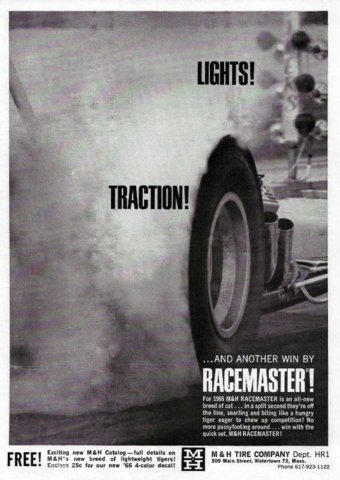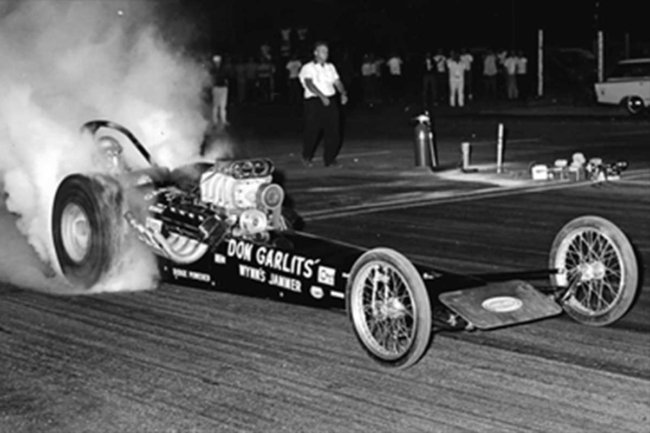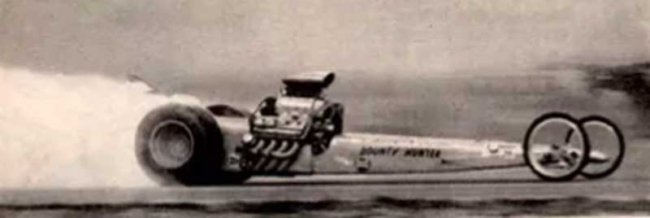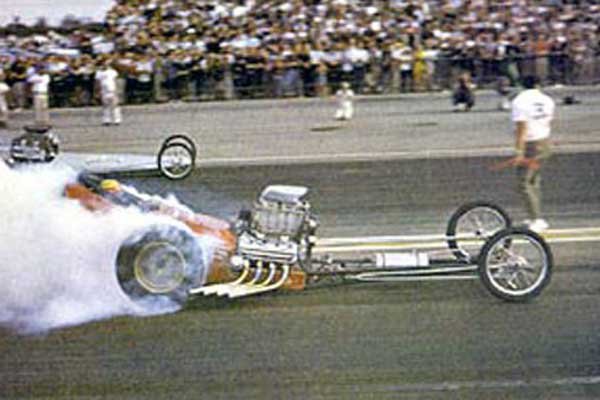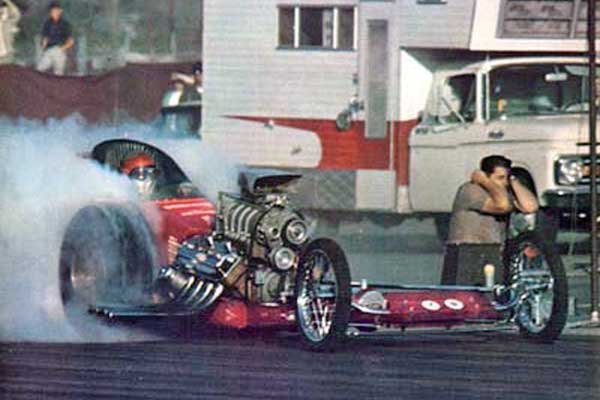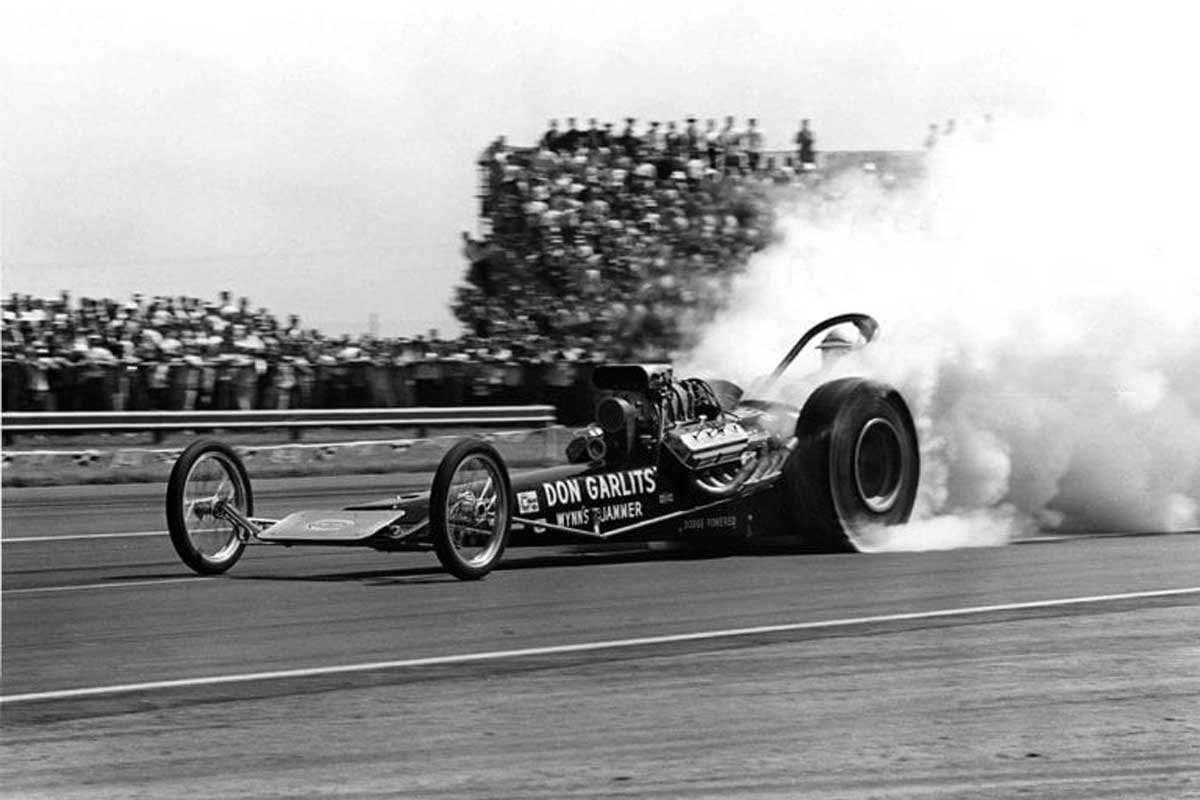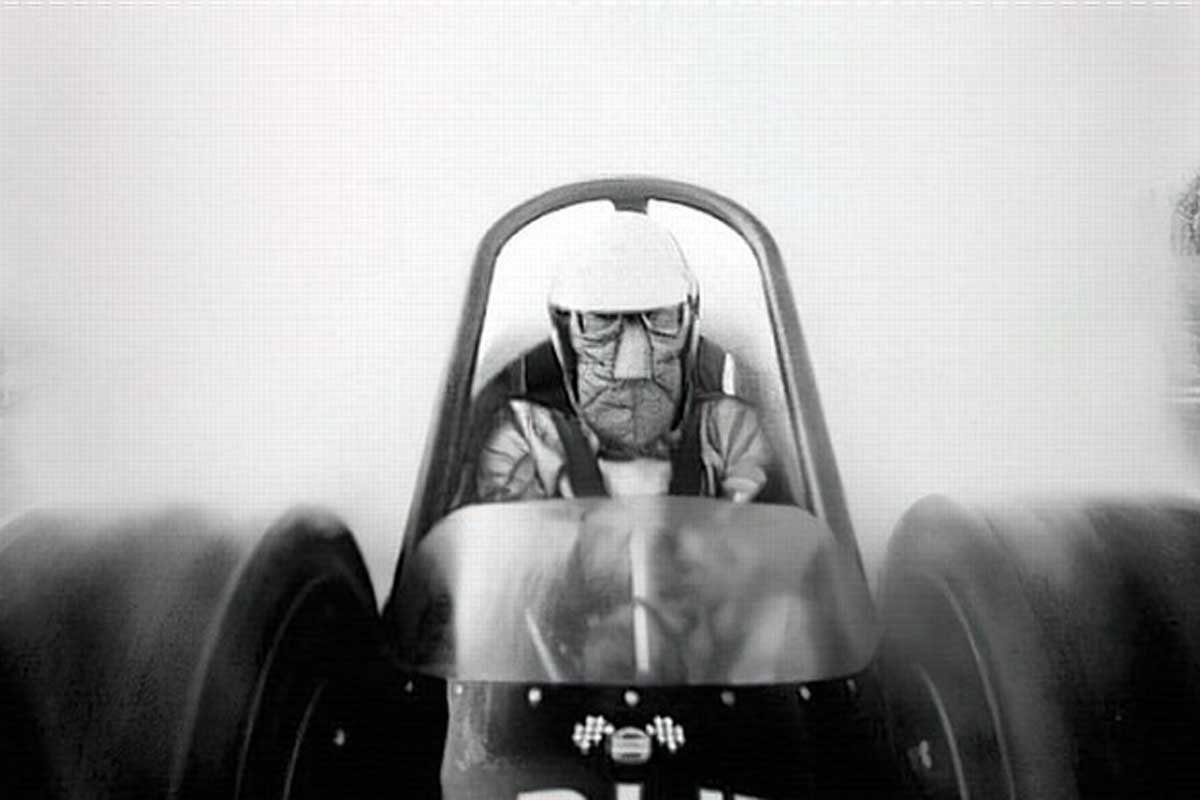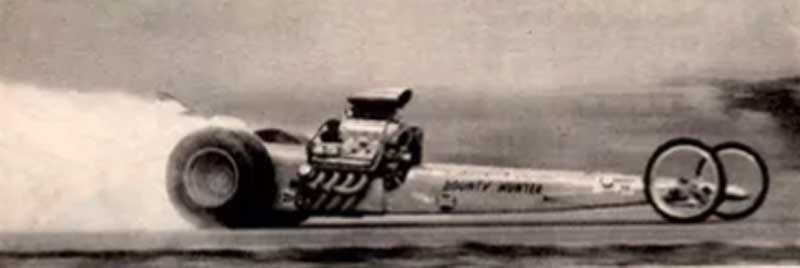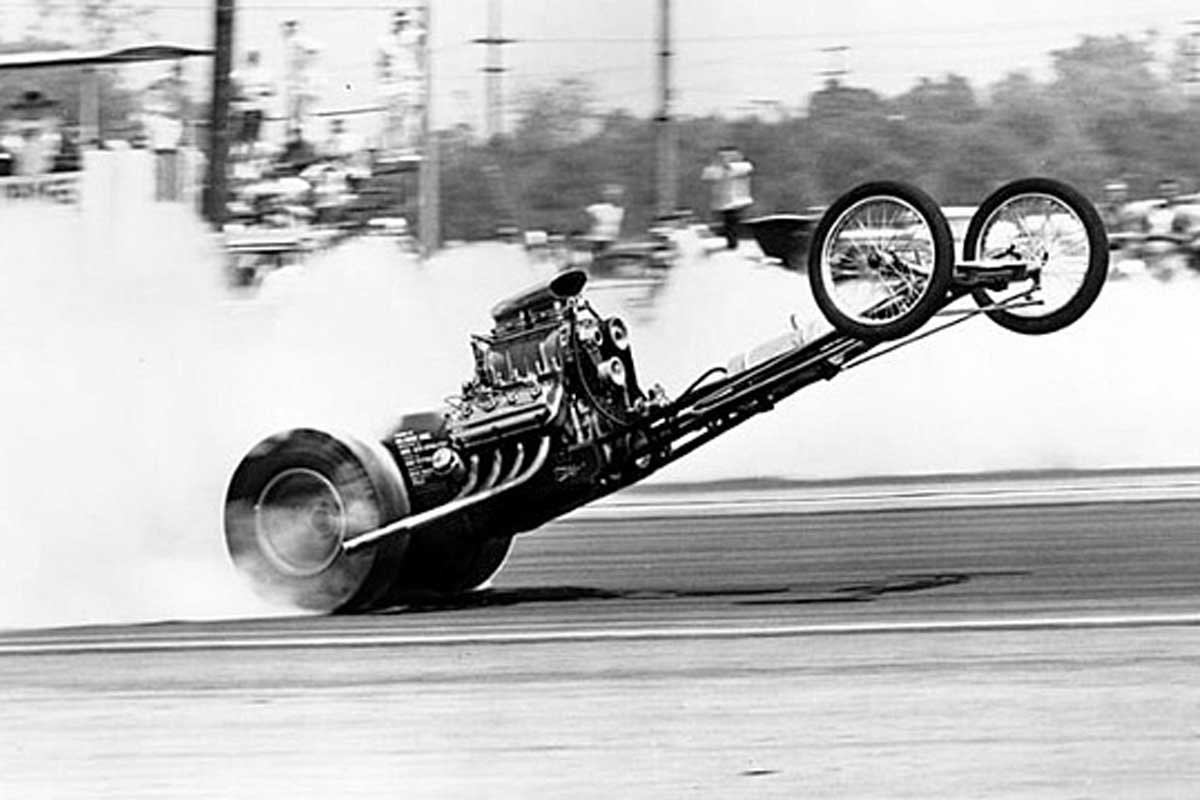
M&H Tire Company, commonly known as M&H Racemaster or M&H, is well-regarded and a testament to the world of drag racing for their exceptional performance and unwavering durability. M&H tires are specifically designed for drag racing applications. They are known for providing excellent traction and consistency, crucial for achieving quick launches and fast acceleration off the starting line, as the 1964 vintage advertisement states, “Ho Hum…Smashing 200 is getting to be a habit with M&H Racemaster Tires.”
Above Left: M&H Tire Co. introduced its products with full-page advertisements. When the 200-mph barrier was broken, it was done on M&H drag slicks. Garlits, Kalitta, and Weekly were heavy hitters in the mid-1960s. Above Right: In 1965, M&H continued its advertising with the Lights!, Traction!, and another win by Racemaster!
The 1960s, a thrilling and dynamic period, witnessed significant developments in race tire construction, particularly for drag racing. By the mid-1960s, Top Fuel dragsters were pushing the boundaries, surpassing the two hundred miles-per-hour mark. Once deemed impossible, the achievement underscored the magnitude of the technological advancements in tire construction, creating an electrifying energy that still resonates today.
In the first decade of drag racing, race tires were primarily crafted from natural rubber compounds, starkly contrasting the advanced synthetic rubber blends used today. The key focus was on acceleration, achieved by slipping the tires rather than the clutch. Most race tires, including those for drag racing, were constructed using bias-ply technology. These tires were built with layers of cords, typically nylon, crisscrossed at an angle, providing robustness and stability. The construction offered the best traction properties for the era, paving the way for future advancements.
Above: “Big Daddy” Don Garlits posted the first 200-mph run in the quarter mile on August 1, 1964. Garlits relied on a supercharged 392 Hemi to provide the horsepower, and he used M&H rear race tires to accelerate his Swamp Rat VI front engine dragster. (Photographers unknown)
The drag racing tires typically featured a slick design with minimal tread patterns. The smooth surface of the slick tire, often a recap design, provided the maximum contact area with the track. The sidewalls were robust and designed to withstand the stresses of launching a high horsepower drag car. They were often reinforced to prevent sidewall flex, which was believed could decrease directional stability, which was proven to be incorrect by the late-1960s.
The 1960s marked a bold shift in tire sizes, focusing on optimizing the contact patch for traction rather than maximizing tire width. The active and pioneering involvement of tire manufacturers such as Goodyear, Firestone, and M&H Racemaster defined this era. Their unwavering commitment and innovative contributions were instrumental in developing tires specifically for drag racing, inspiring future generations with their dedication and ingenuity.

Above: The clutch technology of the day was rudimentary, so the driver relied on slipping the rear tires rather than the clutch. The more tire smoke on the run, the faster the run. Here, Garlits blisters the hides in another attempt to exceed 200 mph. (Photographer unknown)
The manufacturers experimented with different rubber compounds and construction techniques to achieve better grip and faster elapsed times on the drag strip. Overall, race tire construction laid the groundwork for the advancements that would follow in subsequent decades. The focus on maximizing traction and durability with bias-ply slick tires was characteristic of the era, reflecting the evolving demands of drag racing as a competitive motorsport.
The vintage ad features some of the most legendary figures in the world of drag racing, known for their exceptional skills and daring feats. “Big Daddy” Don Garlits, the first to top the 200-mph speed, “The Bounty Hunter” Connie Kalitta, credited with the first official 200-mph run at an NHRA event, and “Stormin’ Norman” Weekly, the second official 200-mph run, all made history with their remarkable achievements. All three men relied on Hemi power to motivate their dragsters.
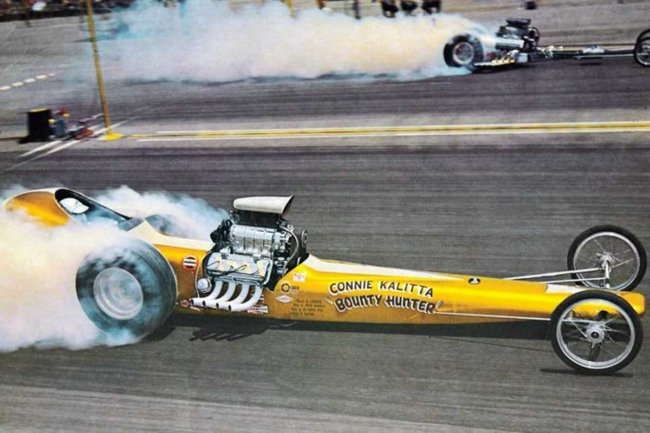
Above: “The Bounty Hunter” Connie Kalitta used a Chrysler Hemi and M&H tires to achieve a 200-mph run at the NHRA Nationals. Kalitta started a little business flying parts, which turned into a vast airline cargo business. (Photographer unknown)
The sport of drag racing saw its first 200-mph pass in the quarter mile on August 1, 1964, at Island Dragway in Great Meadows, New Jersey, when “Big Daddy” Don Garlits drove his M&H-equipped Swamp Rat VI dragster to a 7.78-second elapsed time at 201.34 mph. In addition to the 200-mph run, Garlits was the first Top Fuel drag racer to officially eclipse the 170, 180, 200, 240, 250, and 270 mph marks in the quarter mile. Furthermore, he was the first to top 200 mph in the eighth mile.
Above: By the end of the 1960s, Kalitta had switched to Ford power, but in 1964, he ran a Mopar. As his business grew, Kalitta would step away from drag racing for a few years. He returned and helped Shirley Muldowney during the 1970s. Kalitta moved back into the driver’s seat and again was successful. Upon his retirement, he continued to operate several drag race teams (currently three teams) and Kalitta Air (as owner and CEO). (Photographers unknown)
NHRA ranked its Top 50 Drivers from 1951 to 2000, and Garlits was ranked number 1. During his career, he won multiple championships, was inducted into several Halls of Fame, and won many awards.
Connie Kalitta was the first driver of a Top Fuel Dragster to hit 200 mph (7.86 elapsed time) at an NHRA-sanctioned event, the 1964 NHRA Nationals. Kalitta is also credited as the first Top Fuel driver to hit 290 mph. He was number 21 on the NHRA Top 50 Drivers from 1951 to 2000.

Above: “Stormin’ Norman” Weekly seems to be running the front end a little light. Weekly was one-fourth of a team known as the Frantic Four. He was the second to run 200 mph at an NHRA event. Weekly scored his speed the same weekend as Kalitta at the Nationals. (Photographer unknown)
Kalitta has won two championships and is a member of several Halls of Fame. Further, Kalitta is the owner CEO of Kalitta Air and the owner of Kalitta Motorsports, which fields the team of reigning Top Fuel Champion Doug Kalitta, as well as Shawn Langdon’s Top Fueler and J.R. Todd’s Nitro Funny Car teams.
In 1963, Norm Weekly partnered with Ron Rivero, Jim Fox, and Dennis Holding to pilot the Frantic Four (sometimes written as the Frantic 4) Top Fuel Dragster. In December 1963, he defeated Chris Karamesines in a best of three to earn the Drag News #1 Mr. Eliminator spot—the position the Frantic Four dragster held numerous times during the 1964 and 1965 seasons. At the 1964 Nationals, Weekly posted a 7.81 elapsed time at 202.24 mph on M&H tires.
Above: While the Frantic Four was together for less than two years, they were at the top of the Drag News charts multiple times during that short period. The Frantic Four used 392 Hemi power and “old school” weed burner exhaust pipes. Run after run, Weekly and the Frantic Four relied on M&H drag tires. (Photographer unknown)
Weekly drove a few more dragsters after leaving the Frantic Four in mid-1965. He wheeled the Purple Gang (Rapp-Rossi-Maldonado), Don Johnson’s Beachcomber, and Ted Gotelli’s Gotelli Speed Shop Top Fuel dragsters. Weekly moved to Funny Cars at the end of his career (late 1960s), most notably Karamesines’ Barracuda and Doug Thorley’s AMX.
M&H is still around 60 years after the 200-mph barrier was broken. The company has significantly advanced, using the latest technology to design its tires. M&H still has bias-ply tires but has moved into the drag radial arena. Additionally, M&H offers treaded front runners to match the rear tires and tubes for the rear tires. If you need that extra traction on the street or strip, check out Summit Racing‘s huge M&H catalog.



